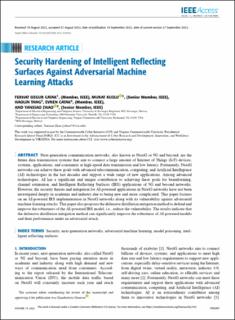| dc.contributor.author | Catak, Ferhat Özgur | |
| dc.contributor.author | Kuzlu, Murat | |
| dc.contributor.author | Tang, Haolin | |
| dc.contributor.author | Evren, Catak | |
| dc.contributor.author | Zhao, Yanxiao | |
| dc.date.accessioned | 2022-10-05T13:29:22Z | |
| dc.date.available | 2022-10-05T13:29:22Z | |
| dc.date.created | 2022-09-16T08:44:07Z | |
| dc.date.issued | 2022-09-14 | |
| dc.identifier.citation | Catak, F. O., Kuzlu, M., Tang, H., Catak, E., & Zhao, Y. (2022). Security Hardening of Intelligent Reflecting Surfaces Against Adversarial Machine Learning Attacks. IEEE Access. | en_US |
| dc.identifier.issn | 2169-3536 | |
| dc.identifier.uri | https://hdl.handle.net/11250/3024102 | |
| dc.description.abstract | Next-generation communication networks, also known as NextG or 5G and beyond, are the future data transmission systems that aim to connect a large amount of Internet of Things (IoT) devices, systems, applications, and consumers at high-speed data transmission and low latency. Fortunately, NextG networks can achieve these goals with advanced telecommunication, computing, and Artificial Intelligence (AI) technologies in the last decades and support a wide range of new applications. Among advanced technologies, AI has a significant and unique contribution to achieving these goals for beamforming, channel estimation, and Intelligent Reflecting Surfaces (IRS) applications of 5G and beyond networks. However, the security threats and mitigation for AI-powered applications in NextG networks have not been investigated deeply in academia and industry due to being new and more complicated. This paper focuses on an AI-powered IRS implementation in NextG networks along with its vulnerability against adversarial machine learning attacks. This paper also proposes the defensive distillation mitigation method to defend and improve the robustness of the AI-powered IRS model, i.e., reduce the vulnerability. The results indicate that the defensive distillation mitigation method can significantly improve the robustness of AI-powered models and their performance under an adversarial attack. | en_US |
| dc.language.iso | eng | en_US |
| dc.publisher | IEEE | en_US |
| dc.rights | Navngivelse 4.0 Internasjonal | * |
| dc.rights.uri | http://creativecommons.org/licenses/by/4.0/deed.no | * |
| dc.subject | security | en_US |
| dc.subject | next-generation networks | en_US |
| dc.subject | adversarial machine learning | en_US |
| dc.subject | model poisoning | en_US |
| dc.subject | intelligent reflecting surfaces | en_US |
| dc.title | Security Hardening of Intelligent Reflecting Surfaces Against Adversarial Machine Learning Attacks | en_US |
| dc.type | Peer reviewed | en_US |
| dc.type | Journal article | en_US |
| dc.description.version | publishedVersion | en_US |
| dc.rights.holder | The authors | en_US |
| dc.subject.nsi | VDP::Teknologi: 500::Elektrotekniske fag: 540 | en_US |
| dc.subject.nsi | VDP::Teknologi: 500::Informasjons- og kommunikasjonsteknologi: 550 | en_US |
| dc.source.pagenumber | 100267-100275 | en_US |
| dc.source.volume | 10 | en_US |
| dc.source.journal | IEEE Access | en_US |
| dc.identifier.doi | 10.1109/ACCESS.2022.3206012 | |
| dc.identifier.cristin | 2052279 | |
| cristin.ispublished | true | |
| cristin.fulltext | original | |
| cristin.qualitycode | 1 | |

